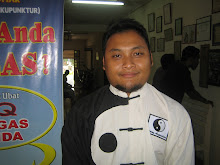
WELL; Studying Acupuncture, One Needle Prick at a Time
By TARA PARKER-POPE
Published: August 24, 2010
For at least 2,000 years Chinese healers have used acupuncture to treat pain and other ailments. Now Western doctors want proof that it works.
There is little dispute that people feel better after receiving the treatment, in which thin needles are inserted deeply into the skin at specific points on the body. But are they benefiting from acupuncture itself, or just getting a placebo effect?
The debate was fueled last week by a study in the journal Arthritis Care and Research. Researchers from MD Anderson Cancer Center in Houston found that among 455 patients with painful knee arthritis, acupuncture delivered no more relief than a sham treatment.
Actually, patients got significant pain relief from both treatments - an average reduction of one point on a scale of 1 to 7. And critics contend that the study was poorly designed.
For one thing, they note, patients in both groups received treatment with needles and electrical stimulation; the main difference was that in the sham group, the needles were not inserted as deeply and the stimulation was far shorter in duration.
In the real world, however, a trained acupuncturist would customize the treatment to a patient's specific symptoms. But in this study, the patients in the ''real'' acupuncture group all received needles inserted in the same way.
Rather than proving that acupuncture does not work, in other words, the study may suggest that it works even when administered poorly. But the real lesson, acupuncture supporters say, is how difficult it can be to apply Western research standards to an ancient healing art.
''People argue that there really are no inactive acupuncture points - pretty much wherever you put a needle in the body is an active point,'' said Dr. Alex Moroz, a trained acupuncturist who directs the musculoskeletal rehabilitation program at New York University. ''There is a body of literature that argues that the whole approach to studying acupuncture doesn't lend itself to the Western reductionist scientific method.''
But the study's lead author, Dr. Maria E. Suarez-Almazor, notes that the sham treatment was developed with the help of trained acupuncturists. In a drug study, an equal response in the treatment and placebo groups would prove the drug does not work, she says.
''We really worked with acupuncturists who are trained in the Chinese traditional style and asked them to come up with a sham that could be credible,'' Dr. Suarez-Almazor said. ''We didn't plan a study trying to show that acupuncture didn't work. The results came out with no difference between the groups.''
The MD Anderson research and other recent acupuncture studies have fueled speculation that the prick of a needle, whether from real acupuncture or a sham version, can influence the way the body processes and transmits pain signals. A 2007 study of 1,200 back-pain patients, financed by insurance companies in Germany, showed that about half the patients in both real and sham acupuncture groups had less pain after treatment, compared with only 27 percent of those receiving physical therapy or other traditional back care.
When the German researchers tracked how much pain medicine the patients used, they detected a noticeable difference between real acupuncture and the sham treatment. Only 15 percent of patients in the acupuncture group required extra pain drugs, compared with 34 percent in the sham group. The group receiving conventional back therapy fared even worse than those receiving fake acupuncture: 59 percent of those patients needed extra pain pills.
The researchers, who published their findings in Archives of Internal Medicine, speculated that inserting needles in or around an area of pain may have caused a ''super placebo'' effect, touching off a series of reactions that changed the way the body experienced pain.
Still another study, this one financed by the National Institutes of Health and published in 2004, found that acupuncture significantly reduced pain and improved function in knee arthritis patients compared with a sham treatment or routine knee care.





No comments:
Post a Comment